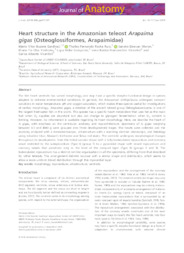Heart structure in the Amazonian teleost Arapaima gigas (Osteoglossiformes, Arapaimidae).
Heart structure in the Amazonian teleost Arapaima gigas (Osteoglossiformes, Arapaimidae).
Author(s): GARDINAL, M. V. B.; RUIZ, T. F. R.; MORON, S. E.; YOSHIOKA, E. T. O.; GONÇALVES, L. U.; VICENTINI, I. B. F.; VICENTINI, C. A.
Summary: The fish heart ventricle has varied morphology and may have a specific morpho-functional design in species adapted to extreme environmental conditions. In general, the Amazonian ichthyofauna undergoes constant variations in water temperature, pH and oxygen saturation, which makes these species useful for investigations of cardiac morphology. Arapaima gigas, a member of the ancient teleost group Osteoglossomorpha, is one of the largest freshwater fish in the world. This species has a specific heart metabolism that uses fat as the main fuel when O2 supplies are abundant but also can change to glycogen fermentation when O2 content is limiting. However, no information is available regarding its heart morphology. Here, we describe the heart of A. gigas, with emphasis on the ventricular anatomy and myoarchitecture. Specimens of A. gigas weighing between 0.3 and 4040 g were grouped into three developmental stages. The hearts were collected and the anatomy analyzed with a stereomicroscope, ultrastructure with a scanning electron microscope, and histology using toluidine blue, Masson's trichrome and Sirius red stains. The ventricle undergoes morphological changes throughout its development, from the initial saccular shape with a fully trabeculated myocardium and coronary vessel restricted to the subepicardium (Type I) (group 1) to a pyramidal shape with mixed myocardium and coronary vessels that penetrate only to the level of the compact layer (Type II) (groups 2 and 3). The trabeculated myocardium has a distinct net-like organization in all the specimens, differing from that described for other teleosts. This arrangement delimits lacunae with a similar shape and distribution, which seems to allow a more uniform blood distribution through this myocardial layer.
Publication year: 2019
Types of publication: Journal article
Unit: Embrapa Amapá
Observation
Some of Embrapa's publications are published as ePub files. To read them, use or download one of the following free software options to your computer or mobile device. Android: Google Play Books; IOS: iBooks; Windows and Linux: Calibre.
Access other publications
Access the Agricultural Research Database (BDPA) to consult Embrapa's full library collection and records.
Visit Embrapa Bookstore to purchase books and other publications sold by Embrapa.

